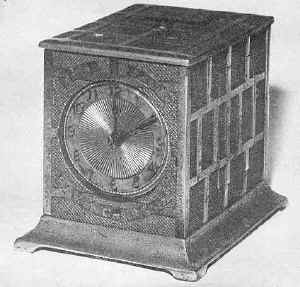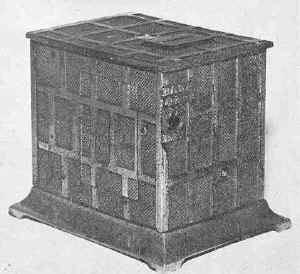Time Lock Savings Bank
by F.H. Griffith - HOBBIES Magazine - September, 1969
 A clock type bank, quite unique among the mechanicals, is of
necessity our choice as No. 176 in the numerical classification. The bank is the Time Lock
Savings, and we say "of necessity" due to the fact that this is a rather rare
bank and actually should be classed with a considerably lower number. This same
circumstance has happened before with a few other mechanicals and will most likely happen
again at some future time or times — it’s not greatly important and there is
nothing we can do about it anyway. A Japanese Ball Tosser or a Coasting Bank could turn up
tomorrow and we would necessarily place either in our numerical classification series as
soon as possible.
A clock type bank, quite unique among the mechanicals, is of
necessity our choice as No. 176 in the numerical classification. The bank is the Time Lock
Savings, and we say "of necessity" due to the fact that this is a rather rare
bank and actually should be classed with a considerably lower number. This same
circumstance has happened before with a few other mechanicals and will most likely happen
again at some future time or times — it’s not greatly important and there is
nothing we can do about it anyway. A Japanese Ball Tosser or a Coasting Bank could turn up
tomorrow and we would necessarily place either in our numerical classification series as
soon as possible.
The Time Lock Savings shown, Figures 1 and 2, is now in the collection of Edwin H. Mosler, Jr. To the best of the writer’s knowledge it is the only known example existing to date. It was found years ago in the Baltimore area, then on to Buffalo where it stayed for some time, from there to Pennsylvania-New Jersey area and then recently to New York City and the Mosler collection.
Other than this we know practically nothing about the bank. That is to say background information is sadly lacking. The writer has never seen it pictured or described in old catalogs. He does not know who designed or manufactured the bank. On the underside of the base of the bank appears "Pat’t Appl’d For" in raised letters. This is of no help at all as so far any search of patents, and the writer has done plenty of this, has brought nothing to light that would have reference to or apply to the Time Lock Savings. All we can do is hope that at some future date we can come up with something, as one thing for sure we never give up trying.
 The bank shown is in fine original condition. It has an all over
nickel plate finish. The face of the clock, Figure 1, is brass and the hand and numerals
are black. Above the face appears "Time Lock" and under the face "Savings
Bank." The rear of the bank, Figure 2, shows the winding hole for the clock mechanism
and an odd shaped aperture on the upper left. Over this aperture appears "Bank Opens
In" and underneath "Days." On the side of the bank, also Figure 2, the
automatic opening door is shown. The same photo shows the raised coin slot on top of the
bank. The decorative casting of the bank is discernible in both photos and self
explanatory.
The bank shown is in fine original condition. It has an all over
nickel plate finish. The face of the clock, Figure 1, is brass and the hand and numerals
are black. Above the face appears "Time Lock" and under the face "Savings
Bank." The rear of the bank, Figure 2, shows the winding hole for the clock mechanism
and an odd shaped aperture on the upper left. Over this aperture appears "Bank Opens
In" and underneath "Days." On the side of the bank, also Figure 2, the
automatic opening door is shown. The same photo shows the raised coin slot on top of the
bank. The decorative casting of the bank is discernible in both photos and self
explanatory.
To operate the bank a dial inside is set for a certain number of days. As example, if it is set for 15 days this number appears in the aforementioned aperture. After 15 days, the clock kept wound and running, of course, the inside mechanism in connection with the clockworks automatically releases the side door and coins may be removed. It is then ready for resetting of the selected number of days.
The Time Lock is a quite unusual bank and the inside mechanism is unusually well made and unique in its operation. Certainly, a number of them must have been made — everything about the bank would indicate this, and it is definitely a commercially produced item. Time alone will tell how many others may have survived.
In any case, the one example has found a good home. Mr. Mosler has recently set up a fine display room for his banks and it does real credit to his ever increasing collection. His interest in varieties has enhanced his collection considerably and is unique in this respect. This phase has also been most helpful to many collectors and certainly enlightening to the writer.
____________________________________
ADDENDA
Shortly after completion of the article on the Time Lock Savings Bank, the writer had the
good fortune in being successful in locating the patent papers covering the bank. The
patent was issued to G.S. Irdell of Philadelphia, Pa., January 31, 1888. There are two
pages of drawings and two full pages of texts describing the mechanism and operation of
the bank. The patent mainly stresses the predetermined time period principle for operation
of the locking and unlocking mechanism in conjunction with the clock. —F.H.G.
